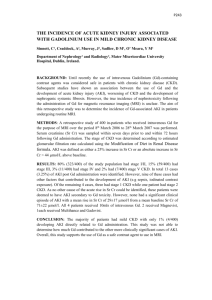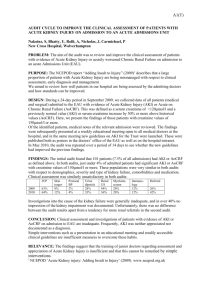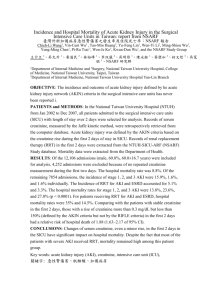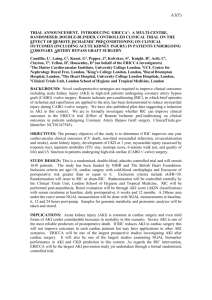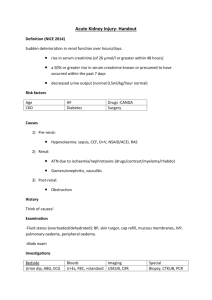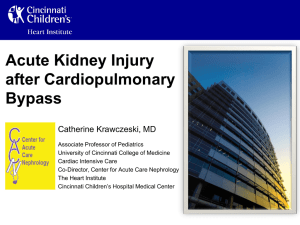Association of Kidney Function and Albuminuria With Prevalent and
advertisement
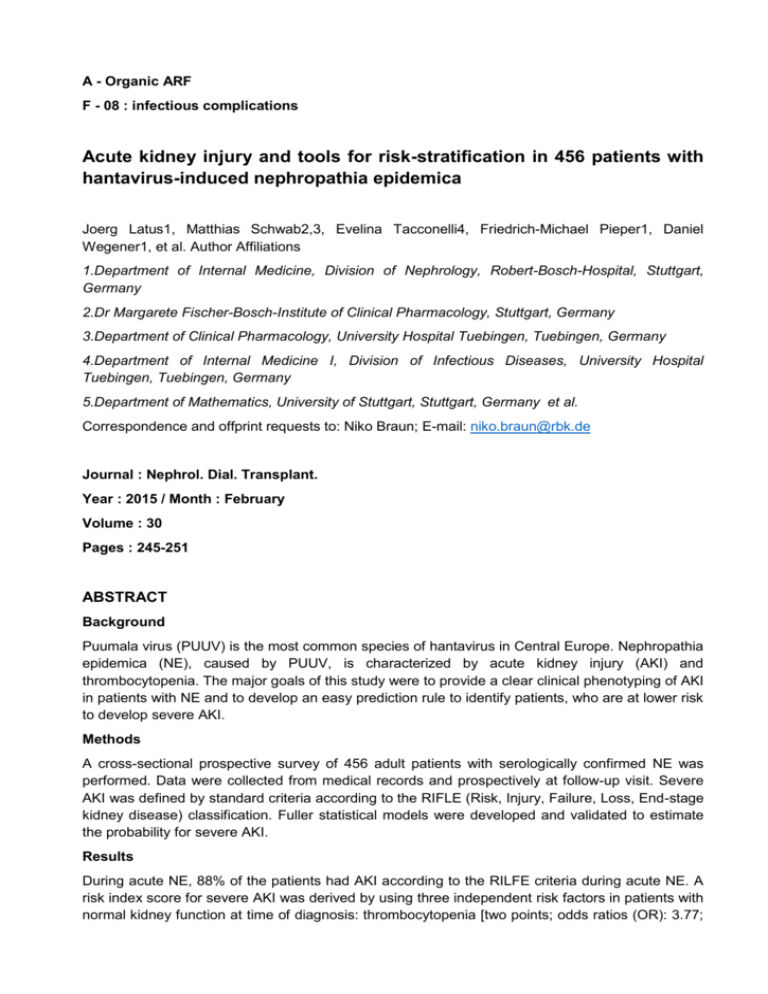
A - Organic ARF F - 08 : infectious complications Acute kidney injury and tools for risk-stratification in 456 patients with hantavirus-induced nephropathia epidemica Joerg Latus1, Matthias Schwab2,3, Evelina Tacconelli4, Friedrich-Michael Pieper1, Daniel Wegener1, et al. Author Affiliations 1.Department of Internal Medicine, Division of Nephrology, Robert-Bosch-Hospital, Stuttgart, Germany 2.Dr Margarete Fischer-Bosch-Institute of Clinical Pharmacology, Stuttgart, Germany 3.Department of Clinical Pharmacology, University Hospital Tuebingen, Tuebingen, Germany 4.Department of Internal Medicine I, Division of Infectious Diseases, University Hospital Tuebingen, Tuebingen, Germany 5.Department of Mathematics, University of Stuttgart, Stuttgart, Germany et al. Correspondence and offprint requests to: Niko Braun; E-mail: niko.braun@rbk.de Journal : Nephrol. Dial. Transplant. Year : 2015 / Month : February Volume : 30 Pages : 245-251 ABSTRACT Background Puumala virus (PUUV) is the most common species of hantavirus in Central Europe. Nephropathia epidemica (NE), caused by PUUV, is characterized by acute kidney injury (AKI) and thrombocytopenia. The major goals of this study were to provide a clear clinical phenotyping of AKI in patients with NE and to develop an easy prediction rule to identify patients, who are at lower risk to develop severe AKI. Methods A cross-sectional prospective survey of 456 adult patients with serologically confirmed NE was performed. Data were collected from medical records and prospectively at follow-up visit. Severe AKI was defined by standard criteria according to the RIFLE (Risk, Injury, Failure, Loss, End-stage kidney disease) classification. Fuller statistical models were developed and validated to estimate the probability for severe AKI. Results During acute NE, 88% of the patients had AKI according to the RILFE criteria during acute NE. A risk index score for severe AKI was derived by using three independent risk factors in patients with normal kidney function at time of diagnosis: thrombocytopenia [two points; odds ratios (OR): 3.77; 95% confidence intervals (CI): 1.82, 8.03], elevated C-reactive protein levels (one point; OR: 3.02; 95% CI: 1.42, 6.58) and proteinuria (one point; OR: 3.92; 95% CI: 1.33, 13.35). On the basis of a point score of one or two, the probability of severe AKI was 0.18 and 0.28 with an area under the curve of 0.71. Conclusion This clinical prediction rule provides a novel and diagnostically accurate strategy for the potential prevention and improved management of kidney complications in patients with NE and, ultimately, for a possible decrease in unnecessary hospitalization in a high number of patients. Key words: acute kidney injury, hanta virus, nephropathia epidemica, predictors for severe course, PUUV COMMENTS Hantavirus diseaseis a single-stranded, enveloped RNA viruses of the Bunyaviridae family for which rodents are the natural reservoir and can lead to haemorrhagic fever with renal syndrome (HFRS) in Asia and Europe, and hantavirus cardiopulmonary syndrome in the Americas with reported case fatality rates of up to 35% . Some fifty years ago, the OMSK fever, was one of the first description of this viral disease coming from Corea but at that time the virus was not identified. Similar descriptions were made in Scandinavic countries under the name of nephropathia epidemica. The clinical picture of NE is characterized by acute kidney injury (AKI) associated with thrombocytopenia and often proteinuria . A small number of patients with severe AKI are at risk to develop severe electrolyte disorders, anuria with fluid overload and uraemia with the requirement for renal replacement therapy or intensive supportive therapy. The aims of this study were to give a clear clinical phenotyping in a representative cohort of patients and to establish a simple prediction score for patients with NE to allow physicians (especially general practitioner or nephrologists) to identify, at time of onset of disease, patients at low risk for severe AKI and subsequent complications. A total of 7476 patients with serologically and clinically confirmed NE were reported to the Robert Koch Institute in Berlin (Robert Koch Institute). AKI was classified on the basis of the RIFLE (Risk, Injury, Failure, Loss, End-stage kidney disease) criteria. Mild/moderate AKI was defined in patients with no AKI and AKI Risk (R) and severe AKI was classified as RIFLE Injury (I) and RIFLE Failure (F). Oliguria was classified as temporary loss of kidney function and refers to a 24-h urine output of <500 mL. Anuria was classified as a 24-h urine output of <50 mL. Leucocytosis was defined as leucocytes >10 × 109/L, and thrombocytopenia was defined as thrombocytes <90 × 109/L. Haematuria was defined as a positive dipstick test for erythrocytes and over two erythrocytes per high-power field. Proteinuria was defined by an albumin/creatinine ratio (ACR) >0.25 g/g creatinine in spot urine sample. 456 patients (29%) were included in the study. This sample represents 6.1% of ever-reported cases of NE in Germany. The median age at diagnosis was 48 years (IR, 40–59); male was the predominant gender (290 male and 166 female). Seventy per cent of patients had AKI according to RIFLE criteria at the time of admission to hospital or to the ambulatory care physician. During the acute course of the disease, serum creatinine increased in 31% of these patients, whereas in the remaining patients a continuous decrease of serum creatinine could be observed. A risk index score was derived by using the following three independent risk factors associated with severe AKI at logistic-regression analysis: thrombocytopenia (two points; OR: 3.77; 95% CI: 1.82, 8.03), 12-fold increase of CrP levels (one point; OR: 3.02; 95% CI: 1.42, 6.58) and proteinuria (one point; OR: 3.92; 95% CI: 1.33, 13.35) at time of presentation in the emergency department or in the outpatient clinic. In patients with no risk factors or only one point using the risk score, the probability of severe AKI was 0.18 (SEM ± 0.06) and 0.28 (SEM ± 0.07), respectively. The model showed satisfactory discrimination with an area under the curve (AUC) of 0.71. In summary, NE is responsible for severe AKI in a high proportion of patients. Thrombocytopenia, elevated CrP levels and proteinuria at disease onset are likely to be associated with severe AKI during the acute course of the disease. The clinical prediction rule developed in this large crosssectional study provides a novel and diagnostically accurate strategy for the potential prevention and improved management of kidney complications in patients with NE and, ultimately, to prevent unnecessary hospitalization in a high number of patients. Pr. Jacques CHANARD Professor of Nephrology
